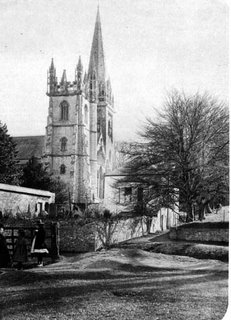The Folly and the Fury: Welsh Disestablishment 1.
As I walk along the path from my home behind Heath Evangelical Church to Canton, a large spire is visible from behind the trees. This is the spire of one of the two towers of Llandaff Cathedral, the closest thing Cardiff has to a metropolitan cathedral. Its location, in the tiny settlement of Llandaff, which was not joined to Cardiff until the construction of the Gabalfa Housing Estate in the last century. Even so, this building housed the 'multi-faith' service that marked the opening of the National Assembly in 1999. Just a century ago, when the Church in Wales was the Welsh Branch of the Established Church, this would have been impossible, such was the bad feeling between Church and Chapel.
to Canton, a large spire is visible from behind the trees. This is the spire of one of the two towers of Llandaff Cathedral, the closest thing Cardiff has to a metropolitan cathedral. Its location, in the tiny settlement of Llandaff, which was not joined to Cardiff until the construction of the Gabalfa Housing Estate in the last century. Even so, this building housed the 'multi-faith' service that marked the opening of the National Assembly in 1999. Just a century ago, when the Church in Wales was the Welsh Branch of the Established Church, this would have been impossible, such was the bad feeling between Church and Chapel.
The story of Disestablishment has been told several times, and I do not propose to tell that story again, but address the spiritual aspect of this particular episode.
The Disestablishment controversy lasted from the 1860s to 1920, when the Church in Wales was separated from the See of Canterbury and constituted as a separate Province of the Anglican Communion. By that time, however, the force had gone out of the argument and if a Bill to Disestablish the Church in Wales had not been introduced before the outbreak of war in 1914, there is every chance that disestablishment would never have taken place, as ecumenism replaced confrontation.
The debates were often heated and sometimes foolish. In fighting Anglicanism, the representatives of Welsh Nonconformity took their eyes off the spiritual declension within their own ranks, while the Anglican Church seemed often to be more interested in political power than holiness. Nevertheless, this episode is instructive as far more than tragedy.
 to Canton, a large spire is visible from behind the trees. This is the spire of one of the two towers of Llandaff Cathedral, the closest thing Cardiff has to a metropolitan cathedral. Its location, in the tiny settlement of Llandaff, which was not joined to Cardiff until the construction of the Gabalfa Housing Estate in the last century. Even so, this building housed the 'multi-faith' service that marked the opening of the National Assembly in 1999. Just a century ago, when the Church in Wales was the Welsh Branch of the Established Church, this would have been impossible, such was the bad feeling between Church and Chapel.
to Canton, a large spire is visible from behind the trees. This is the spire of one of the two towers of Llandaff Cathedral, the closest thing Cardiff has to a metropolitan cathedral. Its location, in the tiny settlement of Llandaff, which was not joined to Cardiff until the construction of the Gabalfa Housing Estate in the last century. Even so, this building housed the 'multi-faith' service that marked the opening of the National Assembly in 1999. Just a century ago, when the Church in Wales was the Welsh Branch of the Established Church, this would have been impossible, such was the bad feeling between Church and Chapel.The story of Disestablishment has been told several times, and I do not propose to tell that story again, but address the spiritual aspect of this particular episode.
The Disestablishment controversy lasted from the 1860s to 1920, when the Church in Wales was separated from the See of Canterbury and constituted as a separate Province of the Anglican Communion. By that time, however, the force had gone out of the argument and if a Bill to Disestablish the Church in Wales had not been introduced before the outbreak of war in 1914, there is every chance that disestablishment would never have taken place, as ecumenism replaced confrontation.
The debates were often heated and sometimes foolish. In fighting Anglicanism, the representatives of Welsh Nonconformity took their eyes off the spiritual declension within their own ranks, while the Anglican Church seemed often to be more interested in political power than holiness. Nevertheless, this episode is instructive as far more than tragedy.
Labels: Welsh Disestablishment

0 Comments:
Post a Comment
<< Home